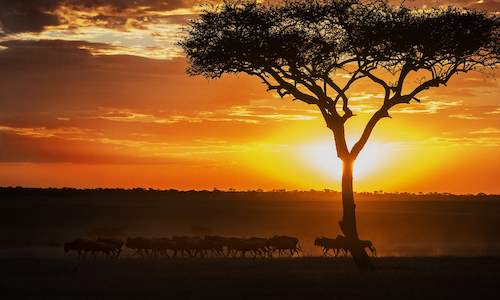
Peoples of Tanazania
Tanzania is an ethnically diverse nation with more than 120 ethnic groups. The Masaai are the most well known of Tanzania's tribes and inhabit the northern regions of the country. The Tanzanian coast is home to the Swahili people, a vibrant mix of Arab, Indian and Bantu origins who historically based their livelihoods around Indian Ocean trade.Africa's Highest and Deepest
Kilimanjaro, the highest mountain in Africa is considered the tallest freestanding mountain in the world, rising 4,600 meters from base to summit. Two of its three peaks—Mawenzi and Shira—are extinct while Kibo, the highest peak is dormant and could erupt again. Kilimanjaro's last eruption was over 200 years ago.The world's second deepest lake, Lake Tanganyika is found in western Tanzania. Lake Tanganyika is home to over 250 cichlid fish species. African cichlid fish are the largest and most diverse radiation of vertebrate species in the world. Lake Tanganyika is also the longest fresh water lake in the world.
Of Dress and Gems in Tanzania
Kitenge is an African garment similar to sarong, worn around the chest or waist, as a headscarf, or as a baby sling. Kitenges are found in striking patterns and bright colours and many of them have short messages printed onto their edges - usually messages relating to love or friendship. Kitenge make great gifts and are light and easy to pack when you are travelling.Tanzania is the world's only source of tanzanite, a semi-precious stone found in the Merelani Hills near Arusha. The deep blue of Tanzanite is magnificent, ranging from ultramarine blue to light violet-blue. The most coveted colour is a blue which shows a purplish hue shimmering around it. The Tanzanite stone is particularly highly prized as it is found in only one place in the world.
Dr Livingstone I Presume
Sir Henry Morton Stanley is particularly remembered for his commission from the New York Herald to find David Livingstone. When they finally met in Ujiji (near Lake Tanganyika) in November 1871 Stanley greeted Livingstone with the words 'Dr. Livingstone, I presume'. A plaque has been erected to indicate the exact place where these famous words were spoken.Cradle of Mankind
Louis and Mary Leakey, the famous archaeologists and anthropologists, spent most of their time working at Olduvai Gorge, Tanzania. In 1960, Leakey's eldest son discovered fossils of Homo habilis, an early human species, at Olduvai Gorge. In the 1970s Mary Leakey's team found hominid footprints in the Laitoli Site, near the Olduvai Gorge. These are thought to date back as far as 3.6 million years.New Species in Tanzania
A new species of monkey, possibily a new genus, was discovered by scientists in Tanzania during 2005. Rungwecebus kipunji is a social species and is said to be a close relative of the baboon. To date, three groups have been found in the Ndundulu Forest Reserve and 16 groups have been found in the Rungwe-Livingstone forest.The Coconut Crab (Birgus latro) which inhabits the waters off Zanzibar's Chumbe Island is the largest crab in the world. The characteristic feature of the coconut crab is the strong pincers and this is what enables it to crack coconuts as well. The coconut crab climbs trees to eat coconuts or fruit, to escape the heat or to escape predators.
Top 10 Destinations in Tanzania
- Ngorongoro Crater
- Serengeti National Park
- Zanzibar and Pemba
- Tarangire National Park
- Lake Manyara National Park
- Mt. Kilimanjaro
- Selous Game Reserve
- Ruaha National Park
- Mafia Island
- Mt. Meru

 Tanzania boasts amazing safari destinations as well as island and beach getaways, making it ideal for a bush and beach safari...
Tanzania boasts amazing safari destinations as well as island and beach getaways, making it ideal for a bush and beach safari... Tanzania fulfils all dreams of Africa, with jungles and primates, wildebeest migrating across rolling grass savannahs, tropical beaches and ...
Tanzania fulfils all dreams of Africa, with jungles and primates, wildebeest migrating across rolling grass savannahs, tropical beaches and ...